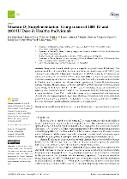Vitamin D3 Supplementation: Comparison of 1000 IU and 2000 IU Dose in Healthy Individuals

Autor
Datum vydání
2023Publikováno v
LifeRočník / Číslo vydání
13 (3)ISBN / ISSN
ISSN: 0024-3019ISBN / ISSN
eISSN: 2075-1729Metadata
Zobrazit celý záznamKolekce
Tato publikace má vydavatelskou verzi s DOI 10.3390/life13030808
Abstrakt
Background: Scientific studies point to a significant global vitamin D deficiency. The recommended dose of vitamin D for the adult population in Central Europe is 800-2000 IU/day. The aim of our study was to determine whether doses of 1000 IU or 2000 IU of vitamin D3 are adequate to achieve the sufficiency reference values of [25(OH)D]. Methods: Seventy-two healthy volunteers, average age twenty-two, took part in the study. The study was conducted from October to March in order to eliminate intra-dermal vitamin D production. Vitamin D3 in an oleaginous mixture was used. The participants used either 1000 IU or 2000 IU/daily for two 60-day periods with a 30-day break. Results: The dose of 1000 IU, taken for 60 days, increased vitamin D levels relatively little. Furthermore, serum vitamin D levels decreased in the 30 days following the cessation of supplementation. Taking 2000 IU daily led to a sharp increase in serum levels which plateaued 30 days after the subjects stopped using vitamin D3 drops. Conclusions: Both doses, taken daily, can help maintain adequate vitamin D levels during the winter months. A daily dose of 2000 IU, however, maintained the desired levels of vitamin D for a longer period.
Klíčová slova
vitamin D, vitamin D deficiency, vitamin D insufficiency, supplementation, serum level
Trvalý odkaz
https://hdl.handle.net/20.500.14178/1831Licence
Licence pro užití plného textu výsledku: Creative Commons Uveďte původ 4.0 International






